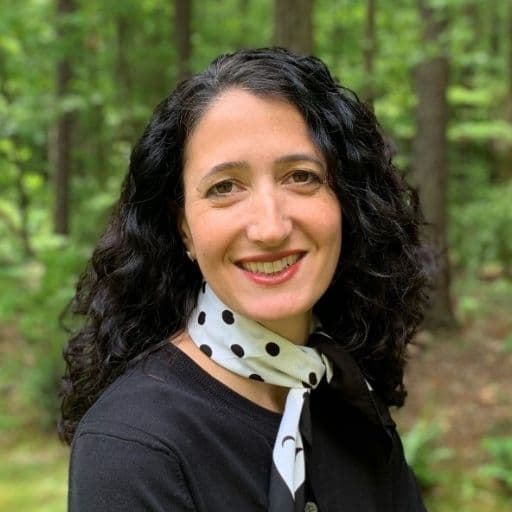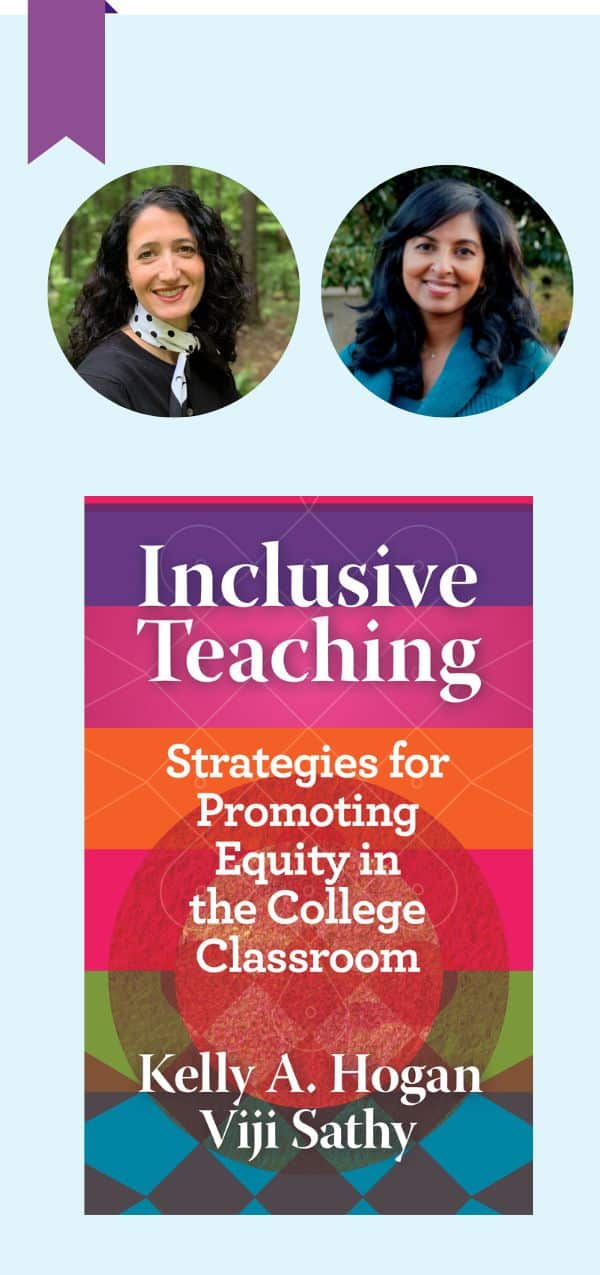‘Inclusive Teaching’: An Interview with Kelly Hogan and Viji Sathy

Kelly Hogan

Viji Sathy

James M. Lang

Like many people, I first encountered the work of Viji Sathy and Kelly Hogan through their popular faculty workshops on inclusive teaching. I had heard such great things about their work, and so assumed that they were writing a book. But because they were both coming from disciplines that tend to focus on publication in academic journals, a book was not on their immediate radar. It was an absolute joy and privilege for me to work with them to bring to life their full vision for inclusive teaching through the Teaching and Learning in Higher Ed series for West Virginia University Press. Their book is one that will make higher education faculty continue to welcome and support all students in their courses for many years to come.
James M. Lang, Ph.D.

The interview
1. We have seen a welcome growth of resources on inclusive teaching over the course of the last decade, and especially in the wake of the pandemic. What new idea or approach did you want to bring to the table in this book?
A welcome growth, indeed! Although we started this book before the pandemic, the past few years have shaped our work and increased interest in our workshops on inclusive teaching. As for our approach, we are both practitioners at heart, so it was important to us that we speak as instructors to instructors about the craft AND science of teaching. Thus, we sprinkle a lot of practical tips and advice throughout the book. We wanted a practical guide that considered how decisions and approaches we make as instructors could include or exclude certain students. For example, throwing a question out to a whole class might feel inclusive because it is available for all to answer, but in reality, we know only a small percentage of students will consistently feel comfortable being engaged this way. By using other ways to participate beyond raising one hand, we can engage more students. In our book, we weave many disparate threads of effective teaching practices into one tapestry through the lens of equity and inclusion. We recognize that we don’t have all the answers, but we hope our readers will feel they have a primer to expand it further in their own work.
2. How much of the book originated from your own research projects or teaching experiences on inclusive teaching practices?
A great deal of the book is based on our many years of experience teaching thousands of students in introductory STEM courses. But we met in a faculty learning community focused on large classes. We discovered there that both of us had noticed common problems in our courses, such as inequities in who was succeeding or differences in who thought the field was not for them. We approached these problems the way we had been trained as scientists: we made some changes, collected data, analyzed it, and our results made us both feel proud of the impact one instructor could have. We had success in narrowing disparities between student groups, reducing failure rates, increasing interest in the subjects, and affecting student feelings of inclusion. Much of the book is based on our 200+ workshops we have conducted for faculty in a wide variety of disciplines on inclusive teaching. Through many different sessions over the years, we learned what resonated with faculty and how we might recommend practical changes that apply to any discipline. Our stories as educators and scientists with boots on the ground implementing these ideas in large classes seemed to resonate with participants too. We had the good fortune to write an advice piece for The Chronicle of Higher Education back in 2019. The reception that this article received helped us to see that we might be able to offer something deeper of value to our colleagues as it pertains to inclusive approaches. We note in the book that we are fairly quiet people, so it is amusing to us that we have amassed a whole book worth of things to share on this topic that we are both so passionate about.
3. Co-authoring a book, or even an article, presents lots of logistical challenges. How did the two of you work together to get the writing done?
We work well together professionally, and we are friends. Our process was to be together to brainstorm ideas and then we would divide and conquer chapters independently. We had a spreadsheet that tracked the common elements we wanted to systematically incorporate in each chapter. We would read each other’s work, give constructive feedback, revise, write more, and repeat. The editorial feedback we received was invaluable and helped us improve as writers. We both very much embrace a growth mindset, so feedback was always seen as helpful in our development. And yes, there were many challenges! The primary one was that we are both non-tenure track faculty and we had little time or resources to support writing a book. We wrote this in pockets of time in the midst of teaching hundreds of students annually, our administrative roles, and our family time. While it was challenging, we also had many moments of fun. We co-wrote on planes and airports together while traveling to deliver workshops and talks. We sat at coffee shops across the U.S and on each other’s screened porches in the summer months. One particular fun moment was when we tweeted out how many of our writing sessions were fueled by LaCroix water. Not long after, cases of LaCroix showed up at our doorstep! (Perhaps this is a good time to say we also deeply enjoyed dark chocolate and prosecco as we met each deadline!)
4. What are three simple, practical strategies for inclusive teaching that readers could implement in their fall courses?
- Post a question and make sure it is available for all to see and hear. How many of us have posed a great question or prompt for students to discuss in small groups only to hear: What did they say we should do? In keeping with Universal Design for Learning principles, it is best to have the question and instructions for students on a screen or paper, in addition to posing it orally. There are many reasons why a student may miss an oral prompt the first time such as notetaking, peers talking, tuning out for a moment, or language barriers. Whatever the reason, this simple technique ensures that everyone has access to the prompt.
- Use multiple strategies for student participation. Because students are diverse, no one technique will engage all learners the same way. We are big fans of using think-pair-share and classroom response systems, but we also love a low-tech strategy with notecards and writing. Students write the answer to a prompt anonymously and then swap cards around the room. They share ideas by reading from the card they receive or an instructor can collect them and select a few to talk about. We share a few more tips on this idea in this ‘Add 5 min of active learning with notecards’ activity.
- Growth mindset in grading (dropping grades, revising work, etc.). We can probably all agree that making mistakes is an important aspect of learning. However, when we look at how grades are constructed in many courses, there is often no room for mistakes in grading schemes. There are some simple remedies for this. For example, can an earlier exam grade be dropped if a student does better on a similar or cumulative exam later in the term? Can the highest score on a quiz in the LMS be retained? In short, can a student make a misstep and not feel that it has derailed them in the course? A low grade may make a student feel as though they do not belong in our discipline. We never want students to feel that a single grade defines them or their capability. So, we encourage educators to look at how their grades are constructed and tweak the grading scheme to emphasize that a misstep or two is expected.
5. Finally, how can readers find out more about you, learn from you, and connect to you? Are you available for virtual and on-campus workshops and presentations? If so, how should people contact you?
We love it when people reach out to us about inclusive teaching. We’ve had the immense pleasure of connecting with colleagues in-person and virtually around the world. These discussions continue to inform our work and we love amplifying the good work of all our colleagues. The easiest way to learn about our research and in-person or virtual workshop offerings is on our website: www.inclusifiED.com.
We are both also active on Twitter and you can find us at: https://twitter.com/vijisathy and https://twitter.com/DrMrsKellyHogan Finally, you can find us on our new Instagram account at https://www.instagram.com/inclusive.teaching.
Excerpt from the book
Do You Intersperse Think-Pair-Share while Teaching?
We call the think-pair-share (TPS) technique the little black dress of active learning, meaning that it is versatile. Although TPS is easy to incorporate, it is often poorly executed. We are observed that many instructors skip the thinking part, and the class is immediately abuzz with discussion of the prompt. But what about students who need time to process the idea and construct their answers before jumping into a conversation? This may apply to introverts, students with learning differences, and multilingual students, to name a few. In a properly executed TPS, the instructor will prompt students to spend a specific amount of time thinking independently. This may sound like: I will give you all one minute to think and write silently about the question. I will then prompt you when the one minute is up and you are able to talk with your partner about your ideas. You will have three minutes to discuss, and I will give you a one-minute warning before time is up. Finally, we will have ten minutes for a group discussion, and I will share details of how that will be done later.
Besides providing explicit instructions for each phase of TPS, that structure may need to be enforced in the pairing as well. Simply stating a turn to a neighbor to discuss might work for many students, but for some there is a realization that everyone around them has been paired up. Some students feel they are always the ones marginalized by peers in a class. Kelly reminds herself of what this feels like when she remembers always being the last one selected to join a volleyball team in middle school gym. It’s uncomfortable to feel like the odd one out and that everyone else seems to have paired up or found a team except you. One way to avoid this is to assign students to groups or pairs that they can work with all the time. Assigning groups (with some student input or flexibility) is inclusive.
Let’s think about another fitness-related example. Viji attended a gym where some work is often done in pairs. Without fail, the instructor asked for anyone without a partner to raise their hand and instructed those with raised hands to pair together. After the first few times of being embarrassed about not having a partner, Viji appreciated that there was an enforcement of this pairing. No one seemed to take it personally and it was a norm in this culture. How can we make this sort of inclusion routine in our classrooms? It may feel uncomfortable to ask if there is anyone in the room who doesn’t have a partner. Instructors can circulate around the room looking for anyone who may need a group. When instructors aid pairing every time there is a TPS technique, students will begin to ensure that it happens without instructor intervention.
At some point, as has happened with us, students come to remark on how much they appreciate the enforcement of pairing. Consider some student feedback to assigned groups in Kelly’s large introductory biology course:
- I usually hate having to talk to people around me during lecture but being put into a group with people you sit by all semester was great. You get to know those people and get comfortable talking with them.
- [working in groups in class] Felt like a more even playing ground, without groups consisting of friends who talked only to themselves.
- I didn’t feel like a burden on the people around me.
This last quote suggests that there were settings where a student felt that their presence in the classroom was a bother to others. While we cann’t know what led to that perception, we do not want any students hindered in their learning by that kind of feeling.
Finally, the last part of TPS is the sharing. In line with our continual emphasis on structure, we recommend having a plan and communicating that plan to your students. For example, you might advise students that you intend to call on a group/pair to summarize their discussion. More structure can be brought to the instructions by asking students to assign a reporter before they begin pairing (more on this later) and giving explicit directions about how much time a response should take (i.e., in sixty seconds or less, share a few of your groups best suggestions). Katelyn Cooper et al. review why whole-class share-outs can be problematic and provide some inclusive alternatives, such as one group sharing with another nearby, using polling technology, notecards, or shared electronic documents (Cooper, Schinske, & Tanner, 2021). Setting up the structure clearly and consistently will enable students to focus more on the learning and less on what will happen next.
For discussion
Sathy and Hogan argue that we can look at almost any teaching practice through the lens of inclusion. We don’t have to radically reimagine our teaching; we have to look at our current practices and ask ourselves a simple question: Are any of my students getting left behind by this practice? And, if so, how can I include them? Can you think of a teaching practice of yours that traditionally has excluded some students? What could you do, or have you done, to make it more inclusive?


